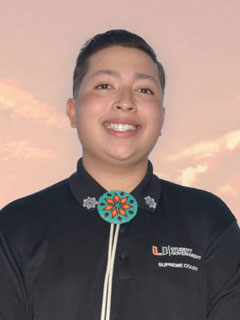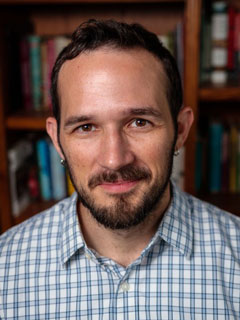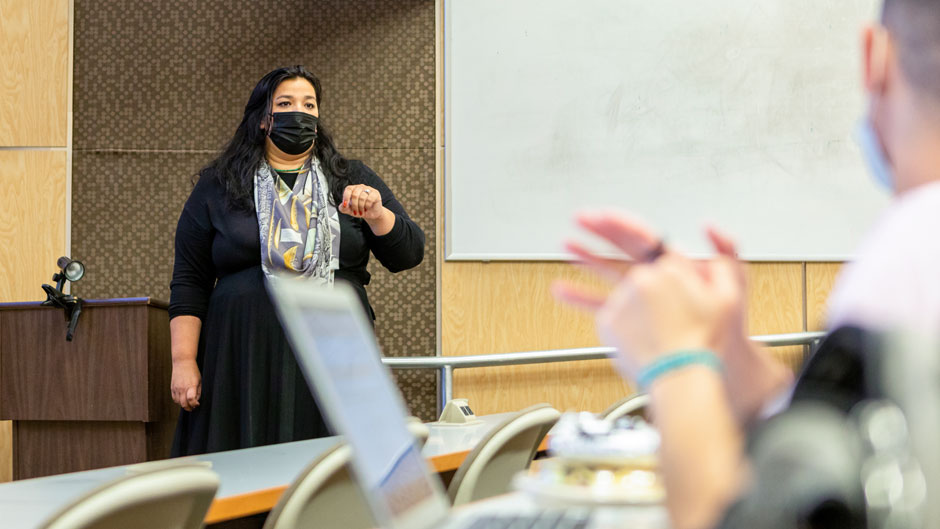For centuries, stories of the colonists and conquistadors overshadowed their vital contributions and rich history.
But Native Americans’ support of the United States—and their relentless devotion to protecting its lands—are beginning to get some national and academic attention. When President Joe Biden appointed Deb Haaland, a member of New Mexico’s Laguna Pueblo tribe, to become Secretary of the Interior last March, it signaled a shift in perspective. So did the Washington, D.C., NFL team’s decision to change their name and logo from a hurtful and offensive depiction of Native Americans, as well as the Cleveland baseball team’s choice to rename their team the Guardians. And now, a group of University of Miami faculty members is hoping to seize the moment and broaden awareness about this sector of our population, so that students will gain a greater appreciation for Native American and Indigenous perspectives.
“We want people at the University to include Native Americans and Indigenous peoples into different kinds of disciplinary conversations going on across campus,” said Tracy Devine Guzmán, an associate professor of Latin American Studies in the College of Arts and Sciences who studies how Indigenous people in the global South work collaboratively. “At the same time, we want to bring awareness to broad questions of social justice that the University has been exploring and to make sure that Native Americans and other Indigenous peoples participate in the conversation.”
Toward that goal, Devine Guzmán and Will Pestle, associate professor and chair of the Department of Anthropology, are leading an interdisciplinary faculty team to propose a new curriculum in Native American and Global Indigenous Studies (NAGIS). Their idea was propelled by a University Laboratory for Integrative Knowledge (U-LINK) social equity grant in 2020 and the group continues to expand as students and faculty members learn about their efforts. This fall, the NAGIS initiative began hosting events that highlight Native American and Indigenous experiences, launched a website, and worked to foster more courses that delve into Native American and Indigenous experiences, one of which is taught by law alumna Caroline LaPorte, a descendant of the Little River Band of Ottawa Indians.
On Nov. 18, NAGIS hosted a session with Dr. James Galvin, professor of neurology, psychiatry, and behavior sciences at the Miller School of Medicine, who has received several federal research grants to study the brain health of Native Americans, including Alaska natives and Hawaiian Islanders. On Dec. 6, NAGIS hosted another event with Sandra Xinico Batz, a Kakchiquel anthropologist, columnist, and educator from Guatemala. The initiative is also offering seven courses this coming spring, and with the support of the dean of the College of Arts and Sciences, is hiring a new faculty member to collaborate with the program. Meanwhile, they also have students exploring an independent minor in Native American and Global Indigenous Studies, according to Devine Guzmán.
“UM students have been very receptive to these ideas, and they want to learn more about Native American and Indigenous perspectives,” she said. “It’s our responsibility as a University to make more educational resources and learning opportunities available, and NAGIS is contributing to that effort.”
While the University’s Native American and Indigenous population is small—there are currently 12 undergraduates, eight graduate students, and two faculty members who self-identify as Native American, about 0.1 percent of the student population—it mirrors national trends. In the United States, just 1 percent of college students identify as American Indian or Alaska Native, and many colleges do not even identify the demographic because it is often too small. According to the Postsecondary National Policy Institute, just 16 percent of Native Americans attain a bachelor’s degree or higher, while 41 percent of Americans between the ages of 18 to 24 are enrolled in higher education.

NAGIS proponents hope that their efforts will attract more students and faculty members who identify themselves as Indigenous, along with those who want to study Indigenous populations. Junior Sarah Cawthon, who is a registered Choctaw, has participated in many of the NAGIS events and is also taking LaPorte’s course this semester: North American Native American and Global Indigenous Perspectives.
“It has been eye-opening to see and learn what issues are currently going on with Native Americans in this country, because a lot of people think of these issues as in the past, but many still exist,” said Cawthon, a Ronald A. Hammond scholar and Foote Fellow majoring in anthropology, geological sciences, and ecosystem science and policy. “It’s also been good for the non-Natives because most of my classmates now have an appreciation for our culture, and it has built a community of allies, or people who can better understand us. Just one class can change your perspective, so it’s been a learning experience for everyone, including myself.”
Cawthon is glad that the University is starting to devote some resources to NAGIS with the first full-time faculty position in Arts and Sciences and hopes it will add more instructors and courses in the future.
“Very few Native Americans go to college,” said Cawthon, who grew up in Dallas. “It’s a really big problem, and I think bringing more attention to what a real Native is today, through this program, will make the University of Miami a more inviting environment for other Native Americans.”

Sophomore Dallas Bennett, who hails from the Eastern Band of Cherokee Indians in North Carolina, agreed. Bennett said that many people from his tribe have attended the University of North Carolina at Chapel Hill because they have a program in American Indian and Indigenous studies, and if Native Americans learned that the University of Miami has a similar program, they may consider it, too.
“In the long run, this will be a steppingstone for the University to build relationships with tribes across the nation and to have more Native American students at the University of Miami,” said Bennett, a history major, with a minor in political science. “Had this happened earlier, it probably would have been one of my minors, but at least now I can take some of the [NAGIS] courses and learn more about other Native American populations.”
English composition lecturer Dan Musgrave, who is a member of the Osage Nation of Oklahoma, said the NAGIS initiative represents a perspective that he believes all college campuses should adopt to undo the damaging stereotypes of Native Americans that persist today. He said this lack of knowledge about Native American and Indigenous people likely springs from the fact that 27 states make no mention of Native Americans in their K-12 curriculum, and 87 percent of state history standards do not mention any Native American history after 1900. That leaves out a host of U.S. policies that harshly discriminated against Native Americans and have dramatically affected their lifestyles today.
“I’ve been in classrooms at other colleges where people were still surprised to learn that Native Americans are still alive,” said Musgrave, who is also a published writer and photographer. “There is a sense if we are not in buckskin and beads, we’re not real Natives. These historical ideas of who Native Americans are, and how they look, is a huge impediment that does actual harm to communities and to individuals. If our people are thought of as purely historical, then the result is an unwillingness or an inability to consider and/or address our very real and very modern needs.”

Yet, Musgrave is optimistic that NAGIS will allow more students to learn the truth about Native Americans, and he is looking forward to teaching a course next fall as part of the program Native North American Narratives. He hopes that it will become an established academic unit at the University.
“It could be a huge strength to UM as a hemispheric university,” he said, “because this program may draw individuals from not only the nearby Miccosukee and Seminole tribes, but Indigenous people from South America, Central America, and the Caribbean.” he said.
To learn more about the Native American and Indigenous Global Studies initiative, see course listings, or to get involved, visit their website, or e-mail nagis@miami.edu.

